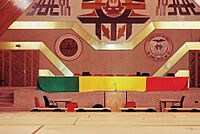National Assembly (Mali) facts for kids
Quick facts for kids National AssemblyBambara: Depitebulon |
|
|---|---|
 |
|
| Type | |
| Type | |
|
Term limits
|
5 years |
| Seats | 147 deputies |
| Elections | |
| Two-round voting | |
|
Last election
|
2020 |
|
Next election
|
2023 |
| Meeting place | |
 |
|
| Bamako, Mali | |
The National Assembly of Mali (Bambara: Mali depitebulon) is the unicameral country's legislative body of 147 voting members.
Members of the National Assembly, called deputies, are elected by direct universal suffrage for a five-year term, during which they enjoy parliamentary immunity. Members are directly elected in single-member districts using a two-round voting system where candidates must receive an absolute majority of votes in order to win.
The Assembly normally meets twice a year, on the first Monday in October for no more than 75 days and the first Monday in April for no more than 90 days. The Prime Minister or a majority of the members can call an extra session. If the session is held at the instigation of Assembly members, it must not exceed 15 days.
The 2013 elections were the first held after the 2012 Malian coup d'état which led to the overthrow of President Amadou Toumani Touré. The current National Assembly was formed following two rounds of parliamentary elections, held on 24 November and 15 December. The Rally for Mali (RPM) party and its allies were victorious, capturing 115 of the 147 seats. RPM Deputy Issaka Sidibé was elected President of the National Assembly on 22 January 2014. Nearly 85% of the members are newcomers serving their first term.
Thirteen of the 147 (8.8%) elected members are women, one less than the previous Assembly. On 12 November 2015, the National Assembly adopted a law requiring that at least 30% of elected or appointed officials must be women.
See also
- History of Mali
- Politics of Mali
- List of legislatures by country
- List of presidents of the National Assembly of Mali
- Legislative branch

